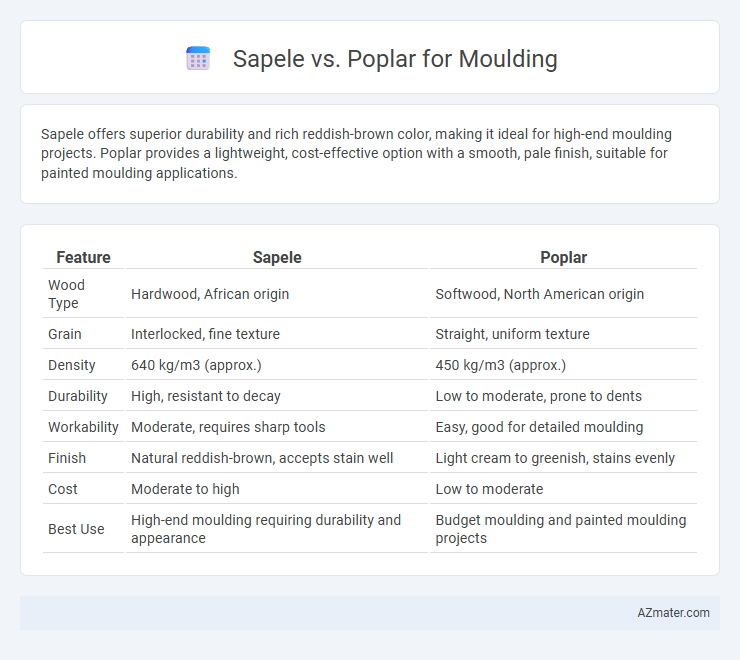Sapele offers superior durability and rich reddish-brown color, making it ideal for high-end moulding projects. Poplar provides a lightweight, cost-effective option with a smooth, pale finish, suitable for painted moulding applications.
Table of Comparison
| Feature | Sapele | Poplar |
|---|---|---|
| Wood Type | Hardwood, African origin | Softwood, North American origin |
| Grain | Interlocked, fine texture | Straight, uniform texture |
| Density | 640 kg/m3 (approx.) | 450 kg/m3 (approx.) |
| Durability | High, resistant to decay | Low to moderate, prone to dents |
| Workability | Moderate, requires sharp tools | Easy, good for detailed moulding |
| Finish | Natural reddish-brown, accepts stain well | Light cream to greenish, stains evenly |
| Cost | Moderate to high | Low to moderate |
| Best Use | High-end moulding requiring durability and appearance | Budget moulding and painted moulding projects |
Introduction: Sapele vs Poplar for Moulding
Sapele offers a rich, reddish-brown hue with a fine grain that provides exceptional durability and resistance to wear, making it ideal for high-end moulding applications. Poplar features a lighter, creamy-white appearance with a softer texture, allowing for easier machining and painting, suited for budget-friendly or painted moulding projects. Choosing between Sapele and Poplar depends on desired aesthetics, durability needs, and finishing preferences in moulding installations.
Wood Origin and Botanical Background
Sapele, originating from West Africa, is botanically classified as Entandrophragma cylindricum and belongs to the Meliaceae family, prized for its deep reddish-brown color and durability in moulding applications. Poplar, native to North America and Europe, is from the genus Populus in the Salicaceae family, offering a lighter, more uniform pale yellow to white hue ideal for primed or painted mouldings. The contrasting botanical backgrounds influence their grain patterns and finishing qualities, with Sapele's interlocking grain providing a distinctive appearance versus Poplar's fine, straight grain favored for smooth surfaces.
Appearance: Color, Grain, and Texture
Sapele features a rich reddish-brown color with a natural luster, exhibiting interlocked grain patterns that create a distinctive ribbon-like effect, making it visually striking for moulding applications. Poplar offers a lighter, creamy to greenish hue with a more uniform and straight grain, resulting in a smoother, less textured surface ideal for painted mouldings. The density and fine texture of Sapele give it a more pronounced depth and elegance, while Poplar's softer texture enhances ease of finishing and versatility in design.
Workability and Machining Properties
Sapele offers excellent workability with its fine, interlocking grain, making it resistant to splintering and ideal for intricate moulding designs. Poplar is softer and easier to machine, providing smooth cuts and less wear on tools but may lack the durability and detailed finish of Sapele. Both woods are commonly used for mouldings, but Sapele's superior stability and resistance to deformation make it preferable for high-quality, long-lasting applications.
Strength and Durability Comparison
Sapele wood exhibits superior strength and durability compared to Poplar, making it a preferred choice for moulding in high-traffic or moisture-prone areas. With a Janka hardness rating of approximately 1,410 lbf, Sapele offers enhanced resistance to dents and wear, whereas Poplar's hardness is significantly lower at around 540 lbf. Sapele's natural resistance to decay and stability under varying humidity conditions further contribute to its long-lasting performance in moulding applications.
Cost and Availability
Sapele is generally more expensive than poplar due to its hardwood status and limited supply, making it less readily available in some markets. Poplar is widely available and more cost-effective, often preferred for budget-conscious moulding projects without heavy wear requirements. Both woods are commonly used in moulding, but poplar offers better accessibility and lower costs for large-scale or domestic applications.
Finishing and Painting Results
Sapele wood offers a rich, reddish-brown hue with natural interlocking grain patterns that produce a smooth, lustrous finish ideal for staining and clear coatings, enhancing the appearance of mouldings. Poplar's pale, uniform surface accepts paint exceptionally well, providing a consistent, smooth base without the need for extensive priming, making it a preferred choice for painted mouldings. Both woods respond well to finishing, but Sapele is favored for natural or stained finishes, while Poplar excels in painted applications due to its fine grain and minimal texture.
Environmental and Sustainability Factors
Sapele, sourced from West African forests, often comes from sustainably managed plantations or certified forests, contributing to reduced environmental impact compared to Poplar, which is primarily harvested in North America and Europe. Poplar grows quickly and is frequently cultivated in short-rotation plantations, enhancing its renewability and carbon sequestration efficiency, making it a highly sustainable choice for moulding applications. Both woods have eco-friendly attributes, but Poplar's rapid growth and forest management practices typically offer a lower ecological footprint than Sapele, which may involve more extensive transportation emissions.
Common Applications in Moulding
Sapele is commonly used for high-end moulding due to its rich reddish-brown color, durability, and fine grain, making it ideal for decorative trims, baseboards, and crown mouldings in luxury interiors. Poplar, on the other hand, is favored for painted mouldings because of its smooth texture and ease of workability, often utilized in window casings, door frames, and baseboards in affordable and mid-range construction projects. Both woods offer versatility, but Sapele is preferred where natural wood aesthetics and hardness are crucial, while Poplar suits applications requiring cost-effective, paint-friendly materials.
Sapele vs Poplar: Which is Better for Your Project?
Sapele offers superior durability and a rich, reddish-brown color that enhances moulding aesthetics, making it ideal for high-end or visible trim work. Poplar is softer, easier to work with, and more affordable, suited for painted mouldings or budget-conscious projects. For projects requiring strength and refined appearance, Sapele is better, whereas Poplar fits well when cost-efficiency and ease of finishing are priorities.

Infographic: Sapele vs Poplar for Moulding
 azmater.com
azmater.com